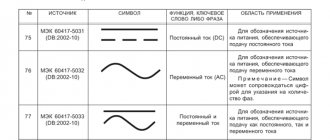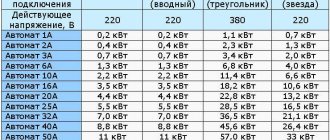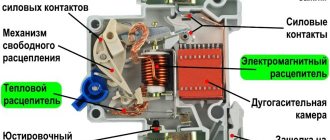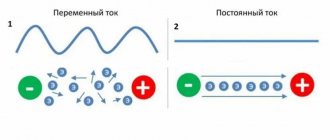What voltage in the household network is optimal for operating electrical appliances?
Voltage level is one of the criteria for the quality of power supply. Each of the household electrical appliances is designed for long-term normal operation provided that it is powered by a voltage within the permissible values. In this article we will consider the question of what voltage in a household network is optimal for the operation of electrical appliances. Voltage level in the electrical network
First of all, it should be noted that the voltage level in the electrical network is influenced by many different factors. Electricity from the source - the power plant - comes to the end consumer, in particular to residential buildings, after going through several stages of transformation. In the first stage, the voltage is increased to transmit it over long distances through the power grid. As it approaches the end consumer, electricity goes through several stages of voltage conversion to values used in everyday life.
It is impossible to ensure fixed voltage values in different parts of the power system, since various processes are constantly occurring in the power system: the load increases or decreases, the amount of electricity generated at power plants changes accordingly, emergency situations arise in different parts of the power network, which to one degree or another affect to voltage levels. Therefore, at each stage of electricity conversion, the voltage level is adjusted, both upward and downward.
The main task of voltage regulation is to ensure the voltage level in certain sections of the electrical network is within acceptable values. The same applies to the final stage, which provides a reduction in voltage to the value used in everyday life - 220/380 V.
In the single-phase electrical network with a voltage of 220 V, which is most often used for power supply to consumers, normally permissible voltage deviations are within +/- 5%. That is, the voltage range of 209-231 V is normal, it can be constant, keeping the network voltage within these values is one of the criteria for high-quality power supply.
But, as mentioned above, emergency operating conditions may occur in the electrical network, which can affect the voltage levels in the electrical network. In this regard, there is another standard - maximum permissible voltage deviations, which are +/- 10% or 198-242 V.
These voltage deviations are allowed for a short period of time, as a rule, during the elimination of an emergency situation in the electrical network or during operational switching, during which a temporary change in the voltage values of the electrical network occurs.
What voltage in the household network is optimal for operating electrical appliances?
Above are the general voltage standards for the electrical network. As for household electrical appliances, in most cases they are designed for normal operation in the range of maximum permissible voltage deviations, that is, 198-242 V. Moreover, electrical appliances should not fail in the event of a short-term voltage exceeding 242 V.
If we consider the ranges of permissible voltages in the passports of household electrical appliances, we can distinguish two groups of electrical appliances. The first group includes those electrical appliances that are least susceptible to voltage surges - an electric kettle, an electric oven, a boiler, an electric heater and other electrical appliances in which the main structural element is a thermal heating element.
The second group includes electrical appliances that are most susceptible to voltage surges - these are, first of all, computer equipment, power supplies for various equipment, audio and video equipment and various expensive electrical appliances that have electronic circuits and converters.
In the passport of electrical appliances of the first group, in most cases you can see a recommended operating voltage of 230 V. In fact, these electrical appliances will work at a lower voltage, but at the same time they will work less efficiently.
Electrical appliances of the second group, as they are more susceptible to voltage surges, are designed taking into account operation in wide ranges. Often the operating voltage ranges are below the maximum permissible. For example, the power supply for audio-video equipment and a mobile phone charger are designed to operate within 100-240 V.
Separately, household appliances that have an electric motor, pump or compressor should be highlighted. The listed elements are designed to operate at rated voltage, usually 220-230 V.
If the voltage in the electrical network decreases, the load current in the electric motor (pump, compressor) increases, which in turn leads to overheating of its windings and a decrease in the service life of the insulation. In this case, the lower the voltage in the electrical network, the shorter the service life of these electrical appliances, in particular their structural elements - electric motors (pumps, compressors).
Taking into account the permissible voltage ranges of all electrical appliances used in everyday life, we can conclude that the most optimal voltage in the electrical network is a voltage of 230 V. At this voltage value, electrical appliances with electric motors, heating elements, as well as electrical appliances that have electronic circuits will operate normally and converters.
When considering the question of what voltage in a household network is optimal for the operation of electrical appliances, it should be taken into account that not only the voltage level is important, but also its stability.
Stability means the absence of voltage surges, both upward and downward. Voltage fluctuations negatively affect the operation of electrical appliances and, ultimately, can lead to their failure.
The artificial intelligence of our site has decided that these articles will be especially useful to you:
Power supply of industrial enterprises - Voltages of supply and distribution networks
Page 2 of 14
GOST accepts the following rated voltages: in networks up to 1000 V: 36; 220/127; 380/220; 660/380 V; in networks above 1000 V: (3); 6; 10; 20; 35; 110; 150; 220; 330; 500; 750 kV. The most advantageous voltage for a given enterprise depends on many factors, the main of which are the power consumed by the enterprise, its distance from the power source and the voltage at which the power can be produced. To power industrial enterprises, voltages from 6 to 220 kV are used, depending on the factors mentioned. Voltages of 330 and even 500 kV are supplied to very large energy-intensive enterprises. Electricity distribution at the first stage of large enterprises is carried out at an external supply network voltage of 110 kV, and sometimes 220 kV, using deep inputs of 110-220 kV supply lines. 110 kV deep bushings are mainly used. Deep 220 kV bushings are appropriate in cases where this voltage is the supply voltage and, therefore, no intermediate transformation is required. If the supply network voltage is higher than 220 kV, i.e. 330 or 500 kV, and a receiving transformer substation is being built at the border of the enterprise, then it is more profitable to use deep bushings for a voltage of 110 kV. Voltage 35 kV can be used for medium-sized enterprises. We recommend deep 35 kV inputs into the enterprise territory in the form of main lines, to which 35/0.4 kV transformers are connected without the use of an intermediate voltage of 6 or 10 kV. At large enterprises, a voltage of 35 kV as a main voltage is insufficient and can only be used to power large electrical receivers with a rated voltage of 35 kV (steel-smelting furnaces, mercury rectifier units) or to power individual remote loads. A voltage of 20 kV has some fundamental advantages over 10 and 35 kV. It is easier to use in intra-shop networks than a voltage of 35 kV; this will require lighter and cheaper devices and cables than with 35 kV. When using a voltage of 20 kV, annual costs are reduced compared to the use of a voltage of 10 kV due to the reduction of electricity losses in networks, transformers and other electrical equipment, short circuit currents are reduced, and the power supply to individual remote consumers of both the enterprise itself and the immediate area is somewhat easier. However, despite this, a voltage of 20 kV is not used in industrial enterprises, since it is insufficient for modern large enterprises as a single voltage and higher voltages have to be used in the first stages of power supply. Voltages of 10 (6) kV are used mainly in the second and subsequent stages of energy distribution in large enterprises and in distribution networks of small and medium-sized enterprises. At the first stage of power supply to large enterprises, voltages of 10 (6) kV are appropriate when using conductors. From a comparison of voltages of 10 and 6 kV, we can conclude that for in-plant distribution networks, in most cases, a voltage of 10 kV is advisable as the main one. In this case, the power supply of medium-power electric motors, which are not yet manufactured, for a voltage of 10 kV can be carried out at a voltage of 6 kV using one of the following methods: from transformers installed at the main step-down substation (MSS) or deep input substation (DHS) with split secondary windings , one of which has a voltage of 10 kV, and the other 6 kV, if the total load of electrical receivers at a voltage of 6 kV approaches half the power of the transformer; from individual 10/6 kV intermediate substations in cases where the total power of 6 kV motors is significant, but insufficient to rationally load the 6 kV branch of the split winding of the transformer and at the same time the number of electric motors is large, and their unit powers are relatively small; according to the block diagram, the transformer is a motor, if the number of 6 kV motors is small, their power is significant and they are located separately from each other. The use of a voltage of 6 kV may be appropriate: when the voltage of the generators of the own thermal power plant is equal to 6 kV, especially in cases where a significant part of the enterprise is powered by the latter; with a predominance of electrical receivers with a voltage of 6 kV. (in particular, electric motors); when supplying electric motors with a voltage of 6 kV complete with production equipment. Voltage 3 kV is not used as the main voltage of the distribution network. In GOST it is preserved only for use in existing electrical installations before their reconstruction. In electrical installations up to 1000 V, a voltage of 380/220 V is used with power and lighting electrical receivers supplied from common transformers, but, as a rule, from separate networks. Voltage 220/127 V is used very rarely in reconstructed or expanded enterprises where many electrical installations with the above voltage remain, or in cases where for lighting it is advisable to use separate transformers or special intermediate transformers 660/230/133 and 380/230/ 133 V. In areas with increased danger and especially dangerous for stationary local lighting and hand-held portable lamps, a voltage of 36 V is usually used and only under particularly unfavorable conditions with respect to the danger of electric shock (for example, when working in boilers or other metal containers) for power supply For hand-held portable lamps, a voltage of no higher than 12 V is used. The voltage of 660 V is still used very little. Electrical equipment for this voltage is still produced in very limited quantities and assortment. The feasibility of using this voltage is different for different industries. It is most appropriate at those enterprises where, due to the conditions of the general plan, technology and environment, it is impossible to widely apply the approach of shop transformers to the centers of the loads they feed. At these enterprises (for example, in coal mines, quarries), it is necessary to lay long and branched cable networks of up to 1000 V with a large cross-section. A voltage of 660 V may also be appropriate in enterprises with a very high specific density of electrical loads and concentration of power, for example, in chemical, petrochemical, tire, etc. enterprises. The most appropriate voltage is 660 V in combination with a primary voltage of 10 kV.
- Back
- Forward
What to do if the power supply voltage is higher or lower than normal
Relations regarding the provision of utility services to owners and users of premises in apartment buildings, owners and users of residential buildings, including relations between providers and consumers of utility services (approved by Decree of the Government of the Russian Federation dated May 6, 2011 No. 354) (hereinafter referred to as the Rules). These Rules establish the procedure for monitoring the quality of the provision of utility services, the procedure for changing the amount of payment for utility services when providing utility services of inadequate quality, and also regulate issues related to the onset of liability of providers and consumers of utility services.
Utilities are the activities of a contractor to supply consumers with any utility resource individually or 2 or more of them in any combination in order to ensure favorable and safe conditions for the use of residential, non-residential premises, and common property in an apartment building.
Determining whether there is a deviation from the norm is quite simple.
When the voltage is low, electrical appliances will stop turning on or will work intermittently. With increased voltage, devices can completely fail and “burn out”. If the voltage in the apartment exceeds or falls short of the specified maximum standards, the owner has the right to contact the management company. Procedure:
- The owner makes a complaint to the company servicing the house.
- The electrician measures the voltage, draws up a report of work performed, and records deviations from the norm.
- The owner submits an act to the management company to eliminate the causes of deviations from the norm.
- If the management company refuses to correct the situation, the owner has the right to go to court.
What voltage deviation in the network is considered the maximum permissible?
Inconsistency of electrical network parameters with the required power quality parameters established by GOST 32144-2013 “Electric energy. Electromagnetic compatibility of technical equipment. Standards for the quality of electrical energy in general-purpose power supply systems” negatively affects the operation of electrical equipment. In everyday life, this most often affects the service life of light bulbs (they burn out faster), as well as the operation of household appliances, in particular, refrigerators, televisions, and microwave ovens. In this article we will look at the permissible and maximum voltage deviation in the network according to GOST, as well as the reasons for this problem.
Standards in accordance with GOST
So, we will be guided by GOST 32144-2013, according to which the maximum deviation (both positive and negative) in Russia should not exceed 10% of the nominal. In total we get the following values:
- for a 230V network - from 207 to 253 Volts;
- for a 400V network - from 360 to 440 Volts.
As for the permissible voltage deviation among consumers, GOST states that this value at common connection points is set directly by the network organization, which in turn must satisfy the standards specified in these standards.
In addition, I would like to note that during normal network operation, the permissible voltage deviation at the terminals of electric motors is in the range from -5 to +10%, and for other devices no more than 5%. At the same time, after an emergency mode occurs, it is allowed to reduce the load by no more than 5%.
By the way, I would like to additionally note that on a power source in 0.4 kV electrical networks, according to the standards, the deviation should not exceed 5%, in fact, the same as for consumers themselves. Total, 5% at the source + 5% at consumers, we have 10% of the maximum allowable.
It is important to know the causes of voltage deviations. So, the main reason is considered to be seasonal or daily changes in the electrical load of the consumers themselves. For example, in winter, everyone suddenly turns on the heaters, as a result of which the power grid parameters drop noticeably. We talked about what to do if the voltage in the network is low in the corresponding article!
What is the difference between direct and alternating current
Electric current is a directed flow of electrons from one pole of a current source to another. If this direction is constant and does not change over time, we speak of direct current. One terminal of the current source is considered positive, the second - negative.
It is generally accepted that current flows from plus to minus.
A classic example of a direct current source is an ordinary AA battery.
Such batteries are widely used as a power source in small-sized electronic equipment - for example, in remote controls, cameras, radios, etc. and so on.
Alternating current, in turn, is characterized by the fact that it periodically changes its direction. For example, in Russia a standard has been adopted according to which the voltage in the electrical network is 220 V and the current frequency is 50 Hz. It is the second parameter that characterizes the frequency with which the direction of the electric current changes.
If the frequency of the current is 50 Hz, then it changes its direction 50 times per second.
Does this mean that in a regular electrical outlet that has two contacts, the plus and minus periodically change? That is, first there is a plus on one contact, a minus on the other, then vice versa, etc. and so on.? In reality, things are a little different.
Electrical sockets in the electrical network have two terminals: phase and ground. They are usually called "phase" and "ground". The ground pin is safe and has no voltage. At the phase output with a frequency of 50 Hz per second, plus and minus change. If you touch the "ground", nothing will happen.
Negative impact of parameter deviations
So that you understand the danger of voltage deviations in the network, we provide the following facts for your reading:
- When the value drops below normal, the service life of the electrical equipment used is significantly reduced and at the same time the likelihood of an accident increases. In addition, in technological installations the duration of the production process itself increases, which entails an increase in production costs.
- In a household network, as we have already said, voltage deviations shorten the service life of light bulbs. When the voltage increases by 10%, the service life of conventional light bulbs is reduced by 4 times. In turn, energy-saving lamps begin to flicker when the voltage drops by 10%, which also negatively affects the duration of their operation. You can learn about other reasons for the flickering of fluorescent lamps from our article.
- As for electric drives, due to a decrease in voltage, the current consumed by the motor increases. In turn, this reduces the life of the engine. If the voltage is even a seemingly insignificant 1% higher than normal, the reactive power consumed by the electric motor can increase up to 7%.
To summarize, I would like to note that there are several modern ways to solve the problem: reducing voltage losses in the electrical network, which we wrote about in the corresponding article, as well as regulating the load on outgoing lines and substation buses.
So we looked at the norms for voltage deviation in the network according to GOST. Now you know how low or high this parameter can reach in a three-phase and single-phase AC network!
We also recommend reading:
Electrical current
Once upon a time as a child, my father bought me my first tester TL-4M. I measured everything until a “brilliant” idea came to my head - to measure the current in the socket. As a result, the plugs were knocked out, the shunt burned out in the tester, and I realized that the current is always measured only through the load. Since then, the means of measuring current have made great strides forward, and for this purpose only current clamps are used (transformer method), shunts are practically not used.
The current, more precisely, its value, shape and components, depends significantly on the load. For example, here is what the voltage and current waveform looks like when the dimmer is operating:
Mains voltage and current THROUGH the dimmer
Naturally, current and voltage harmonics are present. Harmonics talk about how voltage and current waveforms differ from sinusoidal ones.
Voltage and current harmonics
Voltage and current harmonics can be seen in graphical form, both in the screenshot above and in table form - from the 1st to the 50th harmonics. For both single-phase and three-phase networks.
What is the permissible voltage in a 220 V network according to GOST: 4 reasons for introducing the standard
The permissible network voltage in most buildings is 220 V. Until very recently, in Russia, as well as in neighboring CIS countries, technical regulations in the field of supply and maintenance of electricity from the time of the existence of the USSR were in force. Thus, GOST 29322-92 and GOST 21128-83 in the new edition of 2014 are well-known in this area. Each of them fixed the value of the average parameter of the supplied voltage, known to us all and painfully familiar - 220 V. However, recently, namely, in 2015, it was decided to introduce a new standard that meets pan-European demands and needs. Find out what the current permissible voltage on the power cable is and what the maximum and minimum values the meters should produce are in this publication.
Voltage standards in Russia.
04.05.2018
“What should be the voltage in the home electrical outlet?” - Most people will mistakenly answer this question: “220 Volts.” Not many people know that GOST 29322-2014 (IEC 60038:2009), introduced in 2015, sets the standard household voltage on the territory of the Russian Federation not at 220 V, but at 230 V. In this article we will make a short excursion into the history of electrical voltage in Russia and Let's find out what the transition to the new normal is connected with.
In the USSR, until the 60s of the 20th century, 127 V was considered the standard for household voltage. This value owes its appearance to the talented engineer of Russian-Polish origin Mikhail Dolivo-Dobrovoolsky, who at the end of the 19th century developed a three-phase system for the transmission and distribution of alternating current, different from the previously proposed Nikola Tesla - two-phase. Initially, in Dobrovolsky’s three-phase system, the linear voltage (between two phase conductors) was 220 V. The phase voltage (between the neutral and phase conductors), which we use for domestic purposes, is less than the linear voltage by the “root of three” - accordingly, for this case we obtain the indicated 127 IN:
Further development of electrical engineering and the emergence of new electrical insulating materials led to an increase in these values: first in Germany, and then throughout Europe, a standard of 380 V was adopted for linear voltage and 220 V for phase (household). This was done for the purpose of economy - as the voltage increases (while maintaining the installed power), the current in the circuit decreases, which made it possible to use conductors with a smaller cross-sectional area and reduce losses in cable lines.
In the Soviet Union, despite the presence of a progressive 220/380 V standard, when implementing the mass electrification plan, AC networks were built mainly using outdated methods - 127/220 V. The first attempts to switch to European-style voltage were made in our country back in the 30s -s of the XX century. However, the massive transition began only in the post-war period; it was caused by the increasing load on the power system, which forced engineers to choose - either increase the thickness of the cable lines or increase the rated voltage. In the end, we settled on the second option. A certain role in this was played not only by the factor of saving materials, but also by the involvement of German specialists who had applied experience in the use of electrical energy with a voltage of 220/380 V.
The transition lasted for decades: new substations were built with a rating of 220/380 V, and most of the old ones were transferred only after the planned replacement of outdated transformers. Therefore, in the USSR, for a long time, two standards for public networks coexisted in parallel - 127/220 V and 220/380 V. The final switch to 220 V of some single-phase consumers, according to eyewitnesses, occurred only in the late 80s - early 90s .
Electric current consumption was constantly growing and at the end of the twentieth century in Europe, a decision was made to further increase the rated voltages in a three-phase alternating current system: linear from 380 V to 400 V and, as a consequence, phase from 220 V to 230 V. This made it possible to increase the throughput ability of existing power circuits and avoid massive installation of new cable lines.
In order to unify the parameters of electrical networks, new pan-European standards were proposed by the International Electrotechnical Commission and other countries of the world. The Russian Federation agreed to accept them and developed GOST 29322-92, requiring electricity supply organizations to switch to 230 V by 2003. GOST 29322-2014, as mentioned above, sets the value of the rated voltage between phase and neutral in a three-phase four-wire or three-wire system to 230 V, but allows the use of systems with 220 V.
It is worth noting that not all countries have switched to a common voltage standard. For example, in the USA, the established voltage of a single-phase household network is 120 V, while most residential buildings are supplied not with a phase and a neutral, but with a neutral and two phases, allowing, if necessary, to power powerful consumers with linear voltage. In addition, in the United States the frequency is also different - 60 Hz, while the pan-European standard is 50 Hz.
Let's return to domestic power grids. A five percent change in their nominal value should not affect the functioning of conventional household electrical appliances, since they have a certain range of permissible supply voltage values. Both values - 220 and 230 V, in most cases, are included in this range. However, certain difficulties may still arise during the transition to European standards. They, first of all, will affect the operation of lighting equipment with incandescent lamps designed for 220 V. An increase in the input voltage will cause overheating of the tungsten filament, which will negatively affect its durability - such lamps will burn out more often. Therefore, buyers should be more careful and choose electric lamps that can be connected to a 230 V network (the rated voltage is usually indicated in the device labeling).
In conclusion, it should be said that various emergency situations that arise in domestic power grids (sudden voltage drops or power outages) pose a much greater danger to electrical equipment than the planned transition to European power supply standards. In addition, energy supply companies often do not comply with power quality requirements, allowing large deviations from the established nominal values.
Special devices - voltage stabilizers and uninterruptible power supplies - can protect modern equipment from the harmful effects of various network fluctuations. The group produces this equipment with different output voltages: 220 V, 230 V or 240 V.
More information about Shtil voltage stabilizers:
Inverter voltage stabilizers "Calm". The lineup.
Full voltage standards in the electrical network: GOST
Despite the fact that the majority of ordinary people and people who do not belong to the category of knowledgeable in the field of voltage in their electrical network will affirmatively say that the standard voltage is 220 V. To their surprise, even despite the old and familiar stickers, on which indicates the generally accepted standard are no longer relevant.
Since 2015, a new standard has been in force in the Russian Federation - levels of 230 V and 400 V, which corresponds to European standards.
Such acts have also been adopted in Ukraine and the Baltic countries, including Belarus.
What did the change in standard lead to:
- The operating voltage on the power cable has changed;
- Fluctuations have become a little more significant than before, but still within the acceptable limits of 5% and the maximum – 10%;
- The potential payment for electricity supply services has not increased by a completely symbolic amount;
- Voltage supply frequency – 50 Hz.
Differences between DC and AC current
The movement of charged particles (electrons and ions) that is directed or ordered is called electric current. Electric current can be alternating current or direct current.
An electric current with constant properties and direction is called constant. Direct current is necessary for the operation of all electrical appliances.
All electrical equipment powered by a battery also consumes DC current.
The battery and accumulator are sources of direct current; with the help of a converter it can be converted into alternating current. Direct current and alternating current, what are their differences?
Everyone knows that the voltage supplied by the outlet is 220 Volts, but it is not constant, but the maximum voltage can reach readings of over 300 Volts.
Accordingly, a constant current has a direction of movement of electrons and a voltage value that does not change over time, while an alternating current voltage constantly changes. The difference between alternating current and direct current is precisely in the voltage value.
An important characteristic of electric current is frequency
It is measured in Hertz, representing the ratio of the number of repetitions to the period of time during which they were completed. Russia uses a frequency of 50 Hz.
In practice, a frequency of 50 Hz means that the flow of electrons oscillates and its direction changes 50 times per second.
All electrical outlets carry alternating current. The use of alternating current rather than direct current is associated with the ability to transmit electricity over long distances without significant losses.
This is what actually distinguishes direct current from alternating current.
Important
A voltage of 220 thousand volts or more is supplied to the electrical substation, then in a transformer substation located near residential buildings, it is converted from 10 thousand to 380 volts and sent to the consumer.
Electric motors operating on alternating current are much simpler in design and more durable.
Variable is converted into constant using rectifiers. First, a diode bridge is connected to make it unidirectional. A capacitor or smoothing filter must then be connected to correct the dip between the peaks of the sine wave.
Direct current and also alternating current transform in an instant, but with the reverse change things are much worse. That is, it is more difficult to convert a variable into a constant. This requires the use of an inverter, a rather complex and expensive device. As a rule, such a conversion is rarely required, for example, if you need to connect electrical appliances to the vehicle’s on-board network.
Source: https://ampersite.ru/osnovy-elektrotekhniki/postoyannyj-i-peremennyj-tok-v-chem-ikh-razlichiya.html
Standard parameters of the electrical network
The norms of generally accepted standards also regulate the basic parameters inherent in electricity supplied to homes. Taking into account the fact that technical GOST consists of dozens and dozens of pages of complex terminology and calculations, a general assessment of the given categories will be given here. As is generally accepted, the main parameters that determine our household electricity are the frequency and strength of alternating current and voltage. However, there are a number of others that are worth considering.
Standard electrical network parameters include:
- Temporary stress factor;
- Pulse voltage;
- Voltage frequency deviation on the power cable;
- Voltage range;
- Duration of voltage loss and others.
All of the above indicators in one way or another influence the loss or excess of established energy supply standards in the network.
What current is in the sockets, constant or alternating?
Alternating current is one that periodically changes magnitude and direction. Frequency is measured in Hertz (cycle per second). Alternating current is much easier to produce than direct current, and transmission over long distances is also easy. When transmitting electricity, the voltage value can either increase or decrease repeatedly, so sockets are made for a variable value. But there are also electronic devices that are powered by direct current, and they must be converted to the same type. Advantages:
- easy to transmit over long distances;
- simple generating equipment, simplifying the design of electric motors;
- lack of polarity.
Flaws:
- calculations are carried out at the maximum value, in fact no more than 70% is used;
- electromagnetic induction, leading to uneven distribution of electricity across the cross-section of the conductor;
- difficulty in checking and measuring parameters;
- resistance increases because not all of the cable is used.
Maximum voltage deviation in the electrical network
The current in the network is, for natural reasons, not constant and varies in certain parameters. Within the framework of the new 230 V/400 V standard, the nominal deviation is permissible within 5% and a maximum of no more than 10% should be observed in short-term intervals. Thus, such a theoretical deviation is allowed within 198 V and up to 242 V. This range can be considered relevant for most current apartments.
What affects network fluctuations in energy supply and voltage loss:
- One of the most common reasons is obsolescence of equipment, including meters, electrical panels, wiring cables, and so on;
- Significant errors are also observed in a poorly maintained network;
- Errors when planning and performing installation work in the house;
- Significant increase in energy consumption indicators exceeding the established standard.
As already noted, network fluctuations of +-5% are acceptable. So, for example, according to the supplied indicator of 220 volts, the permissible deviation in the network is equal to 209 V and the maximum excess is equal to 231 V.
Voltage drop in the home network
The so-called voltage drop can be fraught with many undesirable consequences. Moreover, it is undesirable both by the residents themselves and by the supplier organization, because it will be the one who will cover all unforeseen expenses. For objective reasons described earlier, power outages can reach record levels.
If you have problems with the voltage in your home network, you should call an electrician
If such fluctuations are detected, the maximum drawdown is recorded and with these indicators, referring to the generally accepted standard and quality of the supplied energy, you need to contact the electricity supply authorities.
If there is no desire to correct the defects, this is grounds for filing a claim in court.
What are the consequences of exceeding or significantly reducing the established norms for voltage supply in the house:
- Light bulbs burn out faster;
- This is especially harmful for a refrigerator, washing machine and other electrical household appliances that require powerful and constant voltage;
- The service life of any electrical equipment, including microwaves, toasters, TVs, computers, and so on.
Thus, it becomes obvious that all classes of electrical engineering suffer from severe voltage fluctuations. This influence is especially destructive if the network voltage is low. And the obligation to provide uninterrupted, stable and high-quality current belongs to the organization that supplies it and, according to the contract, must ensure its high-quality service.
Amount of permissible voltage drop: PUE
According to the accepted rules for the design of electrical installations (PUE) back in the former USSR, a voltage drop is the difference in voltage levels at different points of the network. As a rule, these are the starting and ending points of the chain. In established standards, the law requires a distinction between the concepts of voltage deviation and voltage loss. If the first case, on a generally accepted scale, is considered using the example of an incandescent lamp, the deviation indicator of which is recognized as nominal and mandatory, then in the case of the loss considered on the station buses, this is recognized as a recommended indicator.
Normal voltage drop in the network:
- In so-called overhead lines – up to 8%;
- In cable power supply lines – up to 6%;
- In networks of 220 V - 380 V - in the region of 4-6%.
In this case, a drop in the emergency mode is considered to be a drop of up to 12% in the network - this is the established limit. A fall above the established norm promises the activation of the automatic protective system, which should be activated when the lower norm is reached for at least 30 seconds.
Also in some sources you can find voltage standards that exceed even the new indicators of 230 V and 400 V. Do not confuse examples of domestic use with a plant or factory, where the indicators naturally significantly exceed the domestic environment.
Mandatory voltage regulation in electrical networks
Carrying out your own voltage regulation is not only labor-intensive, but also requires financial investment. An even more difficult option is to seek stabilization of the current in the network from the supplier organization. This can be done by filing complaints, personal appeals, and lawsuits, however, the result is not always achieved even by these methods.
To regulate the voltage in the electrical network, special devices are used
If you still decide to correct the picture yourself, then this is possible in the following way:
- Method of centralized voltage regulation. This approach involves calculating how many changes will be needed to stabilize the situation and adjusting the central power supply accordingly.
- Linear impact method. This is done using a so-called linear regulator, which changes the phases using a secondary winding on the circuit.
- Use of capacitor banks in the network. This method is theoretically called reactive power compensation.
- Also, an extremely unstable network can be corrected using longitudinal compensation. It involves connecting capacitors in series to the network.
Another relevant option, if the deviation from the established norm is not too pronounced, is to install one large or several small stabilizers in the network. This will require some financial investments, special installation skills, and is also not suitable for highly fluctuating power supply systems, because they simply cannot do a large amount of work and regulate a large amount of voltage.
So, as has already been determined, the new generally accepted standard is the network voltage in an apartment from 230 V to 400 V. For example, the voltage scale can be 240 V, 250 V, taking into account the maximum permissible error. However, for the e1f outlet we are used to, the operating voltage is still the same 220V level, which has been familiar to us all since the Soviet period.
How are three phases different from one?
In both types of power there is a working neutral conductor (ZERO). I talked in detail about protective grounding here; it is a broad topic. In relation to zero in all three phases - the voltage is 220 Volts. But in relation to these three phases to each other, they have 380 Volts.
Voltages in a three-phase system
This happens because the voltages (with active load, and current) on the three phase wires differ by a third of the cycle, i.e. at 120°.
You can read more in the electrical engineering textbook - about voltage and current in a three-phase network, and also see vector diagrams.
It turns out that if we have three-phase voltage, then we have three phase voltages of 220 V each. And single-phase consumers (and there are almost 100% of them in our homes) can be connected to any phase and zero. You just need to do this in such a way that the consumption in each phase is approximately the same, otherwise phase imbalance is possible.
Read more about phase imbalance and what causes it - here.
And it is best to protect yourself from phase imbalance using a voltage relay, for example Barrier or FiF EuroAutomatika.
In addition, it will be difficult for the overly loaded phase and it will be offensive that others are “resting”)











